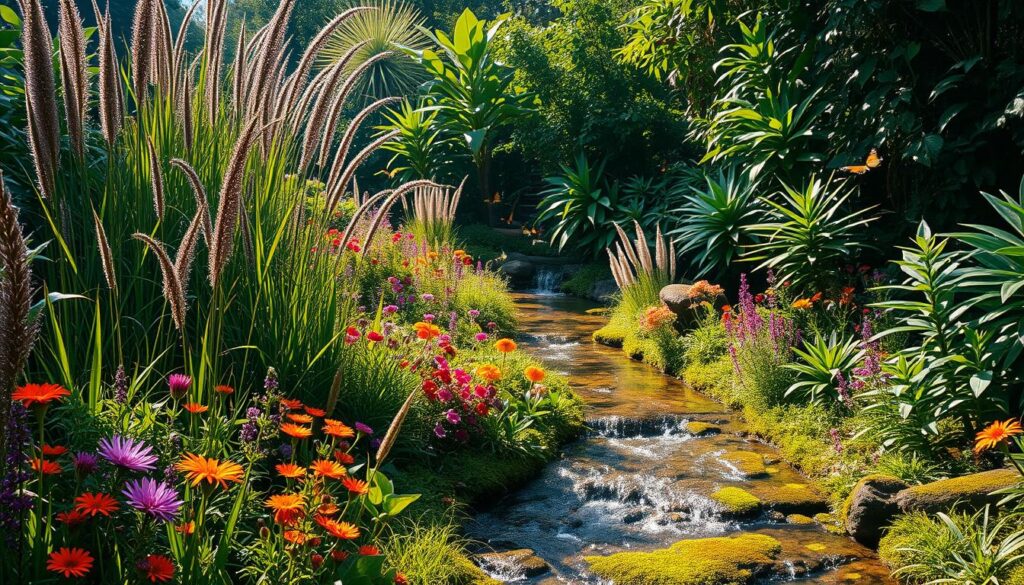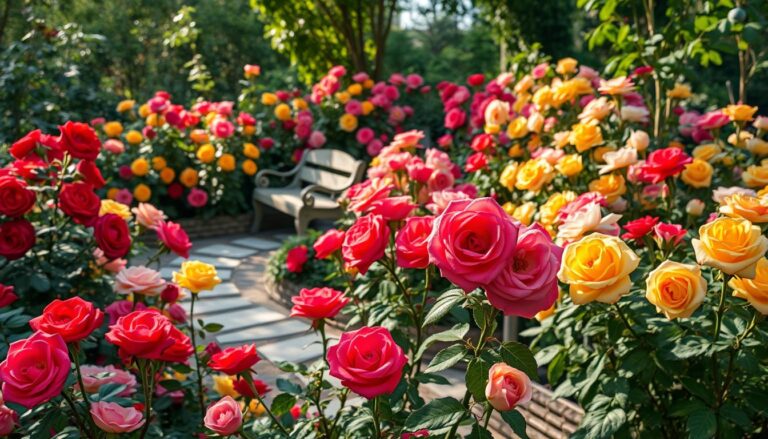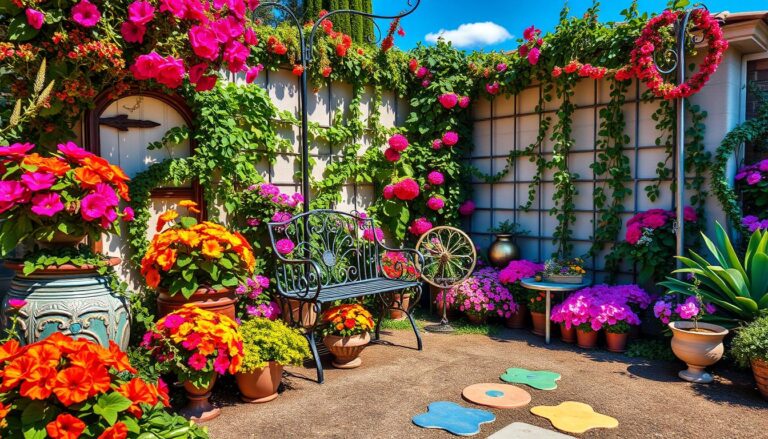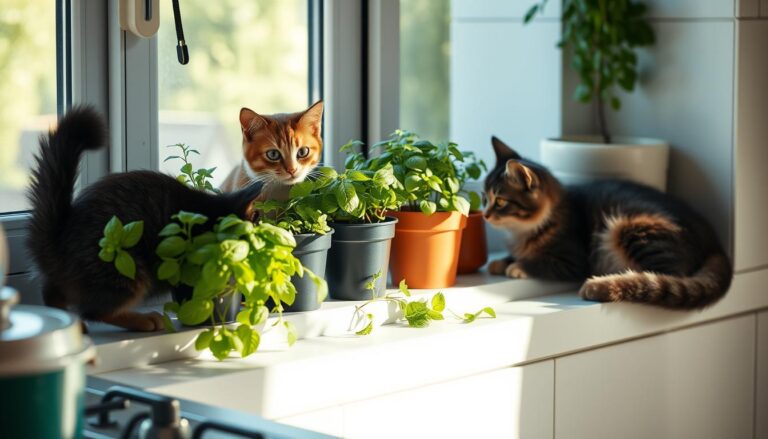Thinking of ways to make your outdoor space better? Rain garden plants might be the answer. They add color and help the environment by attracting pollinators and supporting local ecosystems. Plus, they improve water quality by filtering stormwater before it reaches nearby waterways.
Native plants are key to a thriving rain garden. They love the local weather and soil, making your garden easy to care for. This choice also helps pollinators and supports the environment.
Rain gardens use rainwater wisely, cutting down on the need for expensive irrigation. With the right plants, your garden will be a haven for wildlife. It will attract bees, butterflies, birds, and hummingbirds. By choosing native plants and shrubs, you’ll make your yard both beautiful and useful.
What Are Rain Garden Plants?
Rain garden plants are picked for their love of wet conditions. They help filter rainwater runoff naturally. These plants make your outdoor space both beautiful and helpful to local ecosystems.
When picking plants, think about perennials like Astilbe, Bee Balm, and Butterfly Weed. They grow well in different USDA zones.
A good rain garden has a mix of flowers and leaves. Plant three to seven of each type for the best look. Favorites include Daylilies, Dwarf Fothergilla, and Switchgrass. They make your garden look great and help pollinators and wildlife.
Rain garden plants soak up and clean rainwater, cutting down on pollution. By using a variety of plants, you make a space that’s good for local wildlife and looks amazing.
Consider adding Columbines, Joe Pye Weed, and Rhododendrons to your garden. They’re not just pretty; they also help wildlife. Choose plants that fit your climate and soil for a garden that’s both beautiful and eco-friendly.
Choosing the Right Location for Your Rain Garden
When you’re setting up a rain garden, picking the right spot is key. It’s important for your plants to thrive. Think about the sunlight and soil in the area. These will help you pick the best plants for your garden.
To check your yard’s drainage, look for where water pools or flows. You can also dig a hole and fill it with water. This will show you how fast the water drains. This info helps you pick the perfect spot for your rain garden.
When picking a spot for your rain garden, keep these things in mind:
- Sunlight: Most rain gardens need at least six hours of direct sunlight a day.
- Soil: The soil should drain well and let water through at least 1 inch per hour.
- Drainage: The area should drain in 24-48 hours to avoid soggy soil and root rot.
Choosing the right spot for your rain garden makes it beautiful and useful. With the right plants, you’ll have a lush, green space for years. It’s good for you and the planet.
| Factor | Consideration |
|---|---|
| Sunlight | At least 6 hours of direct sunlight per day |
| Soil | Well-draining with a permeability of at least 1 inch per hour |
| Drainage | Able to drain within 24-48 hours |
Top 10 Rain Garden Plants for Color and Function
Choosing the right rain garden plants is key. Look for native species that love wet conditions. These plants fit well with the local climate and attract pollinators. Good choices include coneflower, black-eyed Susan, and Joe Pye weed.
Here are the top 10 best rain garden plants for color and function:
- Coneflower
- Black-eyed Susan
- Joe Pye weed
- Swamp milkweed
- Little bluestem grass
- Arrowwood viburnum
- Switchgrass
- Swamp hibiscus
- Cardinal flower
- Butterfly weed
These native rain garden plants are perfect because they’re hardy. They handle extremes like too much water or drought. They also help prevent pollution by keeping nutrients and chemicals in the soil.
Adding these plants to your rain garden makes it both beautiful and useful. Make sure to pick plants that match your local climate and soil. This will help your garden thrive.
| Plant | Height | Bloom Time |
|---|---|---|
| Coneflower | 2-4 feet | Summer |
| Black-eyed Susan | 1-3 feet | Summer |
| Joe Pye weed | 3-7 feet | Summer |
Creating a Biodiversity-Friendly Rain Garden
To make a biodiversity-friendly rain garden, pick a mix of native plants from a rain garden plant list. These plants attract pollinators and support local wildlife. Some good choices include coneflower, black-eyed Susan, and butterfly bush. They are easy to care for and attract many pollinators.
Rain gardens can draw in bees, butterflies, and birds, boosting your backyard’s biodiversity. They offer water and a variety of native plants, helping local wildlife. Here are some tips to help you:
- Choose plants that handle different soil moisture levels, like wet, medium, and dry.
- Use plants of different heights to add structure and support wildlife diversity.
- Use mulch, like compost or shredded bark, to stop erosion and keep moisture in.
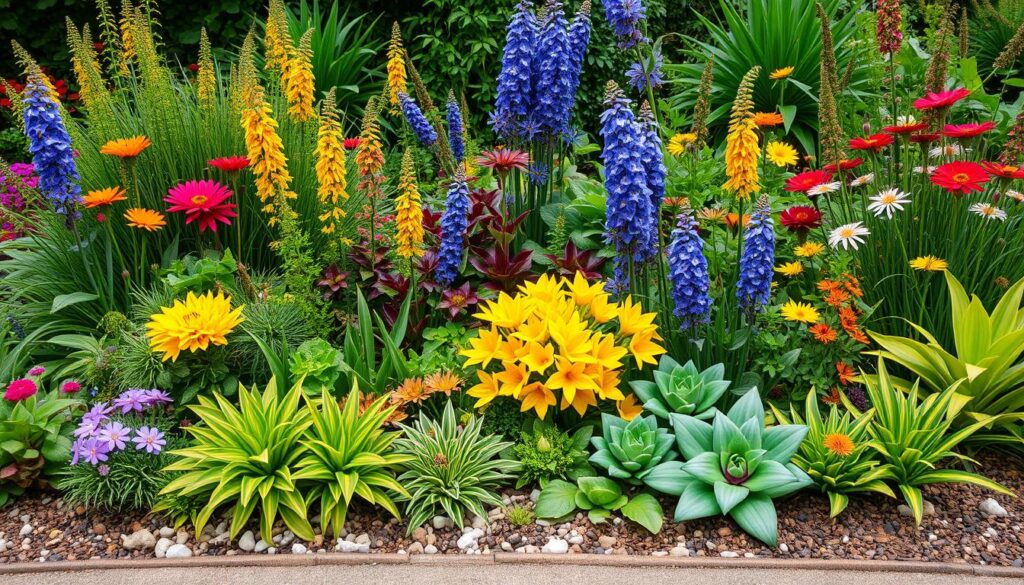
By following these tips and picking the right plants, you can make a rain garden that’s good for biodiversity. It will attract pollinators and support local wildlife, all with low maintenance plants.
| Plant | Height | Soil Moisture |
|---|---|---|
| Coneflower | 2-4 feet | Medium to dry |
| Black-eyed Susan | 1-3 feet | Medium to dry |
| Butterfly Bush | 3-6 feet | Medium to dry |
How to Design Your Rain Garden
Designing a rain garden means thinking about how it looks and feels. You’ll want to mix plants, paths, and borders. It’s also key to pick plants that are easy to care for and fit your local weather. Rain garden plant ideas include native plants like coneflower and black-eyed Susan. These plants are not only pretty but also help pollinators and local wildlife.
To make a rain garden that looks good and works well, watch your landscape for a season. See where water flows after rain or snow. This helps find the best spot for your rain garden.
Layering Plants for Visual Appeal
Layering plants makes your rain garden look great. Use low maintenance rain garden plants like sedges and rushes for a layered effect. These plants are not just pretty; they also clean stormwater and prevent erosion.
Incorporating Paths and Borders
Paths and borders add structure and beauty to your rain garden. You can use stone or wood for these features. They enhance your rain garden plants and make the garden look even better.
Importance of Soil and Amendments
Creating a rain garden means choosing the right soil and amendments. The soil mix is key for rain garden plants to grow well. It also helps with stormwater drainage and filtration. A mix of 50% sand, 25% topsoil, and 25% compost is best for best rain garden plants.
Using native rain garden plants makes the garden easier to care for. These plants fit well with the local climate and soil. They also attract butterflies and birds, adding to the garden’s beauty.
When picking soil and amendments, keep these points in mind:
- Soil infiltration rate: It should be at least 0.5 inches per hour.
- Soil composition: A mix of 50% sand, 25% compost, and 25% topsoil is recommended.
- Amendments: Organic additions like compost or manure can help plants grow and improve soil health.
Choosing the right soil and amendments makes your rain garden thrive. It manages stormwater and creates a home for local wildlife.
| Soil Component | Recommended Percentage |
|---|---|
| Sand | 50% |
| Topsoil | 25% |
| Compost | 25% |
Maintenance Tips for Rain Gardens
Rain gardens are easy to care for, but they still need regular attention. It’s crucial to remove invasive species to keep native plants healthy. Check your rain garden twice a year to spot any unwanted plants early.
Here are some important maintenance tips for rain gardens:
- Watering regularly, specially in the first two years, helps plants grow and establish
- Adding organic matter to the soil improves its structure and fertility
- Dividing and replacing overgrown or struggling plants keeps the garden healthy and diverse
By following these tips and choosing rain garden plant ideas with native species, you can create a stunning and useful rain garden. Regular care also helps prevent flooding, basement backups, and water pollution from stormwater runoff.
| Maintenance Task | Frequency |
|---|---|
| Inspection | Twice a year |
| Watering | Regularly, specially in the first two years |
| Dividing and replacing plants | Every few years, or as needed |
Common Mistakes to Avoid
Creating a rain garden can be tricky. One big mistake is overwatering. This can make the soil too wet and harm the roots. This is a big problem if you choose plants that don’t like too much water.
Another mistake is using plants that aren’t from your area. These plants can take over and hurt the local plants and animals. Instead, pick low maintenance rain garden plants that are native to your area. They need less care and help attract pollinators.
Some common mistakes to avoid include:
- Overwatering, which can lead to waterlogged soil and root rot
- Planting non-native species, which can harm local ecosystems
- Not considering the specific needs of each plant species
To avoid these mistakes, plan carefully. Choose plants from a rain garden plant list that fit your climate and soil. If you’re unsure, ask for advice from local nurseries or gardening experts.

Rain Garden Aesthetics: Combining Form and Function
When designing your rain garden, think about how it will look. You can pick native rain garden plants that are good for managing stormwater and look great. The best rain garden plants fit your local climate and soil, needing less care.
To make your rain garden look good, follow these tips:
- Choose plants with different colors and textures to add depth and interest to the space.
- Add decorative elements like paths, borders, and water features to enhance the aesthetic appeal of the garden.
- Consider the placement of your rain garden, taking into account the slope and drainage of your yard.
By mixing beauty and function, you can make a rain garden that’s both pretty and useful.
Popular rain garden plants include native grasses, wildflowers, and shrubs. These plants are not only beautiful but also attract pollinators and support local ecosystems. By picking the right plants and designing with beauty in mind, you can create a space that’s both functional and stunning.
Rain Garden Plants for Wet and Dry Conditions
Choosing the right plants for a rain garden is key. You want plants that do well in both wet and dry spots. This keeps your garden healthy and strong, no matter the weather. Good choices include low maintenance rain garden plants like Hostas and Ligularia.
For wet spots, Papyrus and Canna Lily are great. They can handle water and moist soil. On the other hand, Phlox and Bee Balm like dry soil and do well in drier areas. Mixing plants that handle different moisture levels makes your garden diverse and lively.
Here are some plants that handle changing wetness well:
- Switch Grass, which grows 3 to 6 feet tall and helps fight soil erosion
- Buttonbush, which grows 5 to 12 feet tall and attracts pollinators
- Chokeberry, which offers various height options and is native to open woodlands and swamps
Adding these plants to your rain garden makes it beautiful and useful. It supports local wildlife and helps manage water runoff.
Make sure to pick plants that fit your climate and soil. Feel free to try out different rain garden plant ideas to find the best mix for your garden.
| Plant | Moisture Tolerance | Height |
|---|---|---|
| Hosta | Wet to dry | 1-3 feet |
| Ligularia | Wet to moist | 2-4 feet |
| Papyrus | Wet | 3-6 feet |
Understanding the Water Cycle in Rain Gardens
Exploring rain garden plants means learning about the water cycle and how they filter stormwater. Rain gardens are key in reducing stormwater runoff and improving water quality. They make your outdoor space beautiful and help the environment.
The best plants for rain gardens are those that grow well locally and need little care. Native plants like Cardinal Flower and Marsh Milkweed are perfect. They filter pollutants and sediments from stormwater, making water cleaner and easing the burden on stormwater systems.
Rain gardens offer many benefits: * They capture about 30% of a site’s total drainage area. * They filter out 80-90% of sediment and nutrients from stormwater. * They provide a home for local wildlife, like pollinators and birds. * They need little upkeep, just like regular gardens.
Teaching others about rain gardens can help make them more popular. This can make your community more sustainable and resilient. Using native or the best plants for your area, you can make a big difference. So, think about adding a rain garden to your space and enjoy its beauty and benefits.
Inspirational Rain Garden Success Stories
Rain gardens can change your property and community. Jim found a lasting solution for drainage, while Kit created a beautiful native plant garden. These stories show how rain gardens make a difference.
EarthGen helped the Highline School District with rain gardens. Harvard College students also worked on a campus project. These efforts teach people about caring for the environment and managing water.
Want to improve your yard or involve your community? Use these rain garden plant lists and species. They help you create a garden that’s easy to care for and good for nature. With the right plants and planning, your rain garden will be a source of pride for years.
FAQ
What are rain garden plants?
Rain garden plants are picked for their love of wet conditions. They help clean rainwater and make your yard look great.
What are the benefits of rain garden plants?
These plants attract pollinators and support local wildlife. They also make your outdoor space beautiful and eco-friendly.
How do I choose the right location for my rain garden?
Pick a spot where water drains well. Think about sunlight and soil too. These affect which plants will do best.
What are the top 10 rain garden plants for color and function?
Native plants are perfect for rain gardens. They include coneflower, black-eyed Susan, and Joe Pye weed.
How can I create a biodiversity-friendly rain garden?
Mix native plants with a water source. This attracts pollinators and supports local wildlife. Plants like coneflower and black-eyed Susan are great choices.
What should I consider when designing my rain garden?
Think about looks and use a variety of plants. Paths and borders add to the design. Choose plants that are easy to care for.
Why is soil and amendments important in a rain garden?
Soil needs to drain well and be rich in organic matter. Choose plants that fit your soil. Compost or manure can help plants grow.
How do I maintain my rain garden?
Rain gardens need little care. Remove invasive plants and add organic matter. Make sure they get enough water and sunlight.
What are common mistakes to avoid when creating a rain garden?
Avoid overwatering and planting non-native species. These can harm your garden and local ecosystems.
How can I combine form and function in my rain garden?
Design your rain garden to be both beautiful and useful. Use plants with different colors and textures. Add paths, borders, and water features for extra beauty.
What rain garden plants can thrive in both wet and dry conditions?
Some plants adapt to changing wetness levels. Choose drought-tolerant plants to keep your garden healthy in dry times.
How can rain gardens help filter stormwater and improve water quality?
Rain gardens reduce stormwater runoff and improve water quality. Educate others to promote rain gardens and a sustainable community.
What inspiring rain garden success stories and community initiatives can I learn from?
Rain gardens can change your community for the better. Share your experiences to inspire others and build a more sustainable community.

